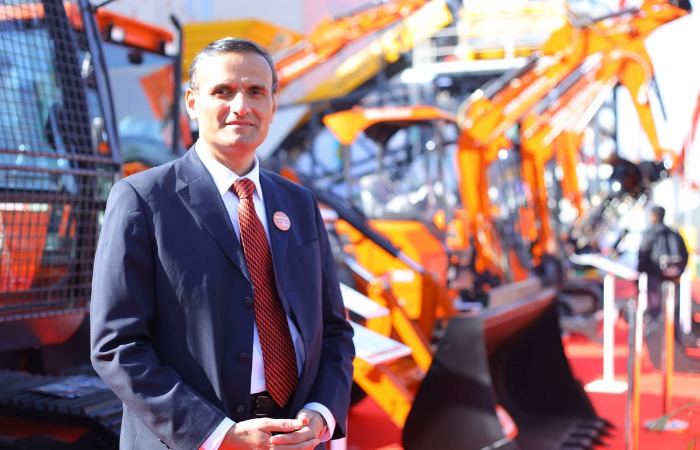
Digital tech are embedded across product and service layers
Siddharth Chaturvedi, Head Marketing, Tata Hitachi Construction Machinery Company.
What are the new products you are showcasing at Excon 2025?
At Excon 2025, we are showcasing a focused line-up that reflects our strategy for India’s next decade of infrastructure and mining: Electrified variants for urban and low-emission zones, next-generation mid-class excavators with platform-based modularity, high-capacity mining solutions optimised for fuel-efficiency, and an integrated telematics suite that ties machines, dealers and customers into a single productivity ecosystem. The selection demonstrates our push on alternate-power technologies, operator comfort and safety upgrades, and products designed for faster serviceability on site. Along with a range of attachments for various applications.
How are your machines addressing the demand for efficiency, safety, and sustainability in India’s infrastructure growth?
Efficiency is being driven through platform engineering — more commonality of parts, powertrain tune-ups, and hydraulic optimisation that lift productivity per litre of fuel.
Safety improvements include advanced operator-assist systems, better cab ergonomics, visibility aids and standardized safety kits across the range. Sustainability is addressed holistically: lower-emission powertrains (hybrid/electric), improved fuel efficiency, recyclable component design and programs for remanufacturing and life-cycle management. Together these elements reduce total cost of ownership while meeting evolving regulatory and customer expectations.
With India focusing on mega infrastructure projects, how do you see the demand evolving for large vs. mid-sized/small equipment?
Megaprojects will sustain demand for large and heavy equipment in mining, ports and expressway construction, while sustained urbanisation and last-mile civil works will keep mid-sized and compact segments robust. In short, demand will bifurcate — larger fleets of high-capacity machines for long-duration megaprojects, and a growing, more frequent need for compact and mid-class machines for urban redevelopment, utilities and smart-city works. Our portfolio and channel strategy therefore prioritise both capacity scaling and flexible, rental-friendly mid-class offerings.
How are you incorporating digital technologies like telematics, AI, or automation in your machines?
Digital technologies are embedded across product and service layers. Telematics is standardised for fleet tracking, utilisation analytics and remote diagnostics. AI and machine-learning are used in predictive maintenance, anomaly detection and optimisation of service cycles to reduce downtime. On the machine side we are deploying operator-assist features (auto-idle, cycle-optimisers, grade-assists) and pilot automation for repetitive tasks. Importantly, these digital systems link into dealer and customer portals so insights become actionable — from spares fulfilment to uptime guarantees.
What role does localisation play in your product strategy for India?
Localisation is central: it reduces lead times, lowers costs, improves serviceability and builds resilience in the supply chain. We are localising not just components but engineering capability — subsystems, tooling, validation and supplier development — while keeping Hitachi’s global quality and testing benchmarks. This approach enables faster product iteration tailored to Indian site conditions, and strengthens our ability to scale production and exports from India.
How is your company addressing after-sales service and spare parts availability in remote project sites?
Our after-sales strategy is multi-pronged: strengthened dealer footprints with dedicated field support, expanded parts depots and regional micro-fulfilment centres, and digital spare-chain forecasting linked to telematics data so high-usage parts are pre-positioned. We also deploy mobile service vans and trained remote teams for on-site repair and component replacement, plus outcome-based service contracts and uptime for large fleet customers to guarantee predictability in remote operations.
What are your growth priorities for the Indian market in the next three to five years?
Our priorities are: (1) accelerate electrified and low-emission product introductions for urban and regulated markets; (2) scale manufacturing and localisation to support exports and domestic demand; (3) deepen digital service and outcome-based offerings that convert uptime into measurable customer value; (4) expand rental and fleet partnerships to reach new user cohorts; and (5) invest in dealer and talent ecosystems to sustain aftermarket excellence and product innovation.
How do you see the rental equipment ecosystem shaping demand for your products?
The rental ecosystem is a major growth enabler — it broadens access, shortens replacement cycles and raises utilisation across project types. For us, rental demand accelerates adoption of mid-class and compact machines, increases demand for robust telematics and remote-monitoring features, and creates opportunities for outcome-based commercial models (long-term rentals with bundled service). We are therefore designing machines for higher utilisation, faster servicing and ease of redeployment, and partnering closely with rental houses to offer tailored financing, maintenance and remanufacturing solutions.


 +91-22-24193000
+91-22-24193000 Subscriber@ASAPPinfoGlobal.com
Subscriber@ASAPPinfoGlobal.com